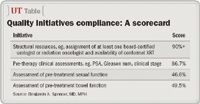Article
U.S. prostate cancer care: Good but needs improvement
San Francisco--The overall level of prostate cancer care in the United States is good, but multiple areas need significant improvement.
San Francisco-The overall level of prostate cancer care in the United States is good, but multiple areas need significant improvement.

"Physicians do less well in quality-of-life assessments, such as [determining] bowel function or sexual functioning before treatment. That has implications for the ultimate treatment outcomes and patients' expectations of the quality-of-life outcomes following treatment: You can't perform high-quality surgery or radiation therapy if you don't know your patient's baseline functional status," he said in a presentation at the recent Prostate Cancer Symposium here.

In the past, physicians and institutions were paid simply for providing patient care. It was assumed that providers offered some minimum level of quality, but reports from the Washington-based Institute of Medicine of the National Academy of Sciences, among others, suggested that substandard care was all too common. If the IOM and third-party payers focus on incentive payments as one method of improving the quality of care, providers are likely to listen.
In the future, Dr. Spencer said, at least a portion of payments will be tied to the quality of care under a variety of pay-for-performance plans. The Centers for Medicare & Medicaid Services has already launched its first pay-for-performance program designed to improve quality of care for Medicare patients. Voluntary reporting of quality data began in January 2006. Under the program, hospitals that provide superior care will receive higher payments than institutions providing care of a lesser quality when measured against standardized parameters.
Few patient-level data sets exist, Dr. Spencer said. Existing administrative data sets have limitations that prevent reliable national comparisons to be made at the patient or hospital level. The current study evaluated quality of prostate cancer care using explicit chart reviews to determine compliance with 25 structural and process quality indicators (QIs) developed by the RAND Corp. These indicators are based on a framework that relates structure, process, and outcomes in health care.
Researchers sifted through 116,671 prostate cancer cases reported to the National Cancer Database on hospital-based care in 2000 and 2001. They selected 5,655 prostate cancer cases, of which 2,683 had undergone radical prostatectomy or radiation therapy between 2000 and 2001. The primary endpoint was compliance with RAND QIs for structural resources, pre-therapy evaluations, counseling, and technical processes of care.
The group also examined the effects of race, geography, and hospital characteristics on QI compliance.
Quality indicator compliance was consistently above 90% for structural resources, such as the presence of at least one board-certified urologist or radiation oncologist and the availability of conformal external beam radiation therapy at a hospital.
Compliance for pre-therapy clinical assessments, such as PSA, Gleason sum, and clinical stage also was high, measuring 86.7% overall. However, when it came to assessing pre-treatment function, the overall score fell to 58%. Sexual function was assessed in just 46.6% of cases; bowel function, in 49.5% of cases.
The survey also found QI compliance varied significantly (p<.05) by geographic region and by type of hospital. Race was a factor, Dr. Spencer said, with African-American patients showing slightly higher compliance than Caucasians, but the difference was not statistically significant.





